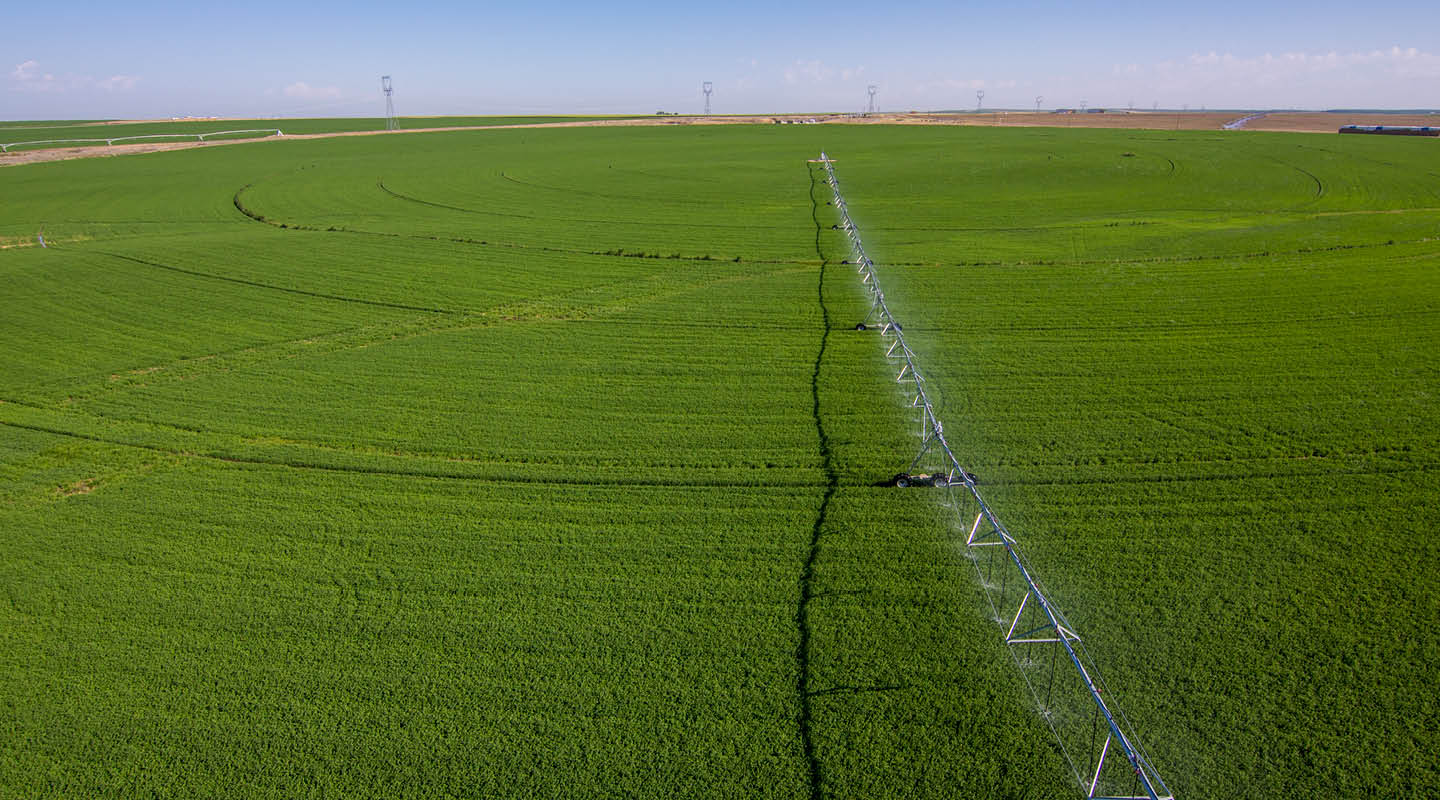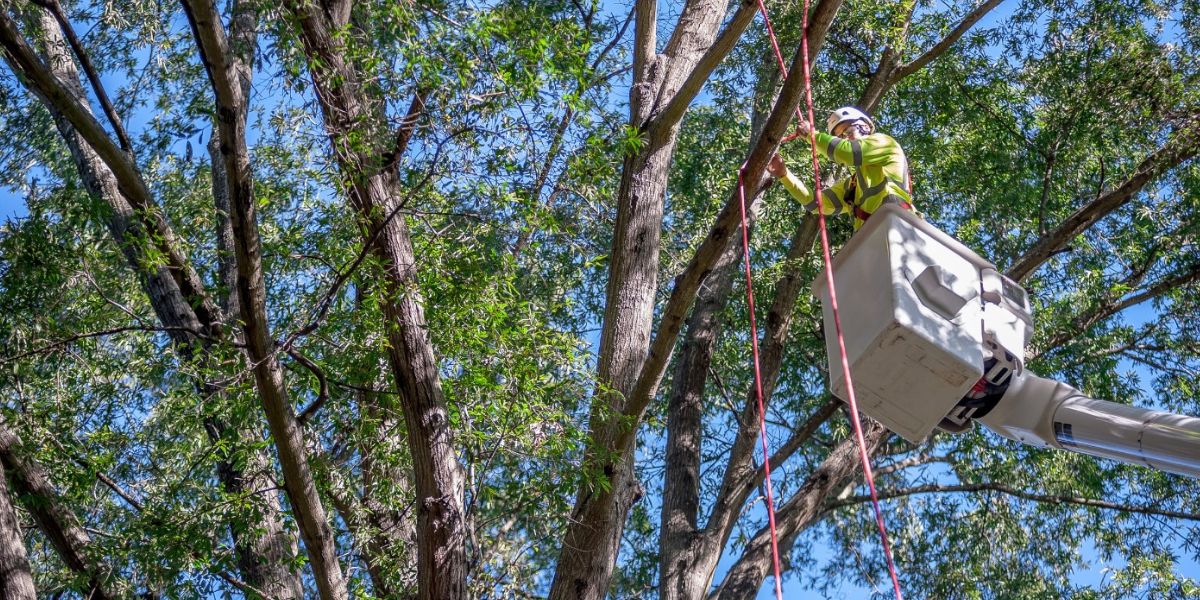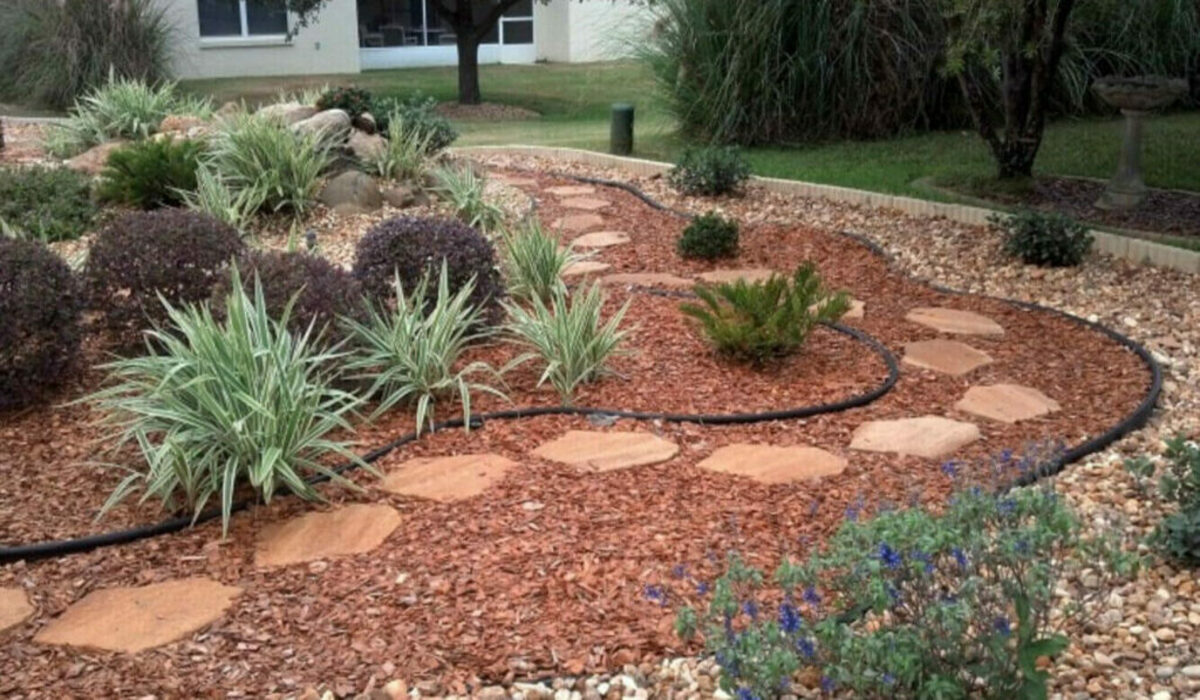(Many of the links in this article redirect to a specific reviewed product. Your purchase of these products through affiliate links helps to generate commission for Chicagolandgardening.com, at no extra cost. Learn more)
Introduction
Pivot irrigation has revolutionized the way we irrigate crops by providing efficient and precise water distribution to maximize crop yield. This irrigation method involves the use of a large circular pipe structure, supported by wheels and driven by a motor, which rotates around a central point. As the pivot moves, water is sprayed onto the crops through sprinklers or drip lines, ensuring optimal moisture levels for growth.
While pivot irrigation offers numerous benefits, one important aspect to consider is the cost. The cost of a pivot irrigation system can vary significantly depending on several factors, including equipment, installation, operation and maintenance, energy, and water costs. Understanding the different components that contribute to the overall cost is crucial for farmers and agricultural professionals seeking to invest in this irrigation method.
In this article, we will explore the various factors that affect the cost of pivot irrigation systems. We will delve into equipment costs, installation expenses, ongoing operating and maintenance costs, energy requirements, and water expenses. By examining these aspects in detail, we aim to provide a comprehensive analysis of the total cost of implementing and maintaining a pivot irrigation system.
By weighing the benefits of pivot irrigation against its associated costs, farmers can make informed decisions regarding the viability and sustainability of this irrigation method for their specific agricultural operations. It is important to note that while upfront costs may seem significant, the long-term benefits of increased crop yield and water efficiency may outweigh the initial investment.
So, join us as we explore the factors that influence the cost of pivot irrigation systems, allowing you to gain a deeper understanding of the financial implications and potential benefits associated with this innovative agricultural practice.
Factors Affecting the Cost of Pivot Irrigation Systems
When considering the cost of a pivot irrigation system, it’s essential to take into account several factors that can influence the overall expenses. These factors can vary depending on the specific requirements of the agricultural operation and the local environmental conditions. Let’s explore the key elements that affect the cost of pivot irrigation systems.
1. Field Size and Shape: The size and shape of the field play a crucial role in determining the cost of a pivot irrigation system. Larger fields require more extensive piping and equipment, which can increase the overall expenses. Additionally, irregularly shaped fields may require custom-designed systems, adding to the installation costs.
2. Water Source and Availability: The availability and quality of water can impact the cost of pivot irrigation. Utilizing a reliable and easily accessible water source, such as a well or reservoir, can reduce upfront costs. However, if the water source is distant or requires extensive pumping, additional expenses may be incurred for pipelines and pumping infrastructure.
3. Soil Conditions: The soil type and its water-holding capacity are critical considerations. Soil that retains moisture well can reduce the irrigation requirements and, consequently, the operational costs. On the other hand, sandy or poorly draining soil may necessitate more frequent watering, increasing water and energy costs.
4. Crop Type and Watering Needs: Different crops have varying water requirements. Some crops may require more frequent irrigation, leading to higher water and energy costs. Additionally, crops with specialized irrigation needs, such as vineyards or orchards, may require specific equipment or irrigation techniques, potentially increasing the system cost.
5. Topography and Terrain: The topography and terrain of the field can influence the complexity and cost of installing a pivot irrigation system. Fields with slopes or uneven terrain may require additional groundwork or leveling, resulting in higher installation expenses.
6. Climate and Environmental Factors: Climate conditions, including temperature, wind, and evaporation rates, can impact the efficiency and effectiveness of pivot irrigation. In regions with high evaporation rates or strong winds, additional water may be required, increasing operational costs. Similarly, extreme temperatures or frost-prone areas may necessitate additional measures to protect the irrigation system, adding to maintenance expenses.
7. Technology and Automation: The level of automation and technology incorporated into the pivot irrigation system can influence the cost. Advanced features like automated control systems, remote monitoring, and variable rate irrigation can improve efficiency and reduce water and energy consumption. However, these advanced systems generally come at a higher upfront cost.
By considering these factors, farmers can make informed decisions about the most suitable pivot irrigation system for their specific needs while managing the associated costs effectively. Next, we will delve into the different cost components of a pivot irrigation system, providing a comprehensive understanding of the expenses involved.
Equipment Cost
The equipment cost is a significant factor to consider when evaluating the overall expense of a pivot irrigation system. The components required for a pivot system include the pivot itself, sprinklers or drip lines, control panels, motors, pumps, pipelines, and other supporting structures. Let’s explore the key elements that contribute to the equipment cost of pivot irrigation systems.
1. Pivot System: The pivot system is the central component of the irrigation system. It consists of the main pivot structure, wheels, and drive components. The cost of a pivot system can vary depending on its size, brand, and any additional features or customization required. The length of the pivot system will depend on the size of the field and the desired irrigation coverage.
2. Sprinklers or Drip Lines: The type and quantity of sprinklers or drip lines needed will influence the equipment cost. Sprinklers can be fixed or rotating, providing different patterns and coverage. Drip lines are commonly used for precise irrigation, delivering water directly to the root zone of plants. The number and spacing of sprinklers or drip lines will depend on the crop type and watering requirements.
3. Control Panels and Electronics: Modern pivot irrigation systems often incorporate advanced control panels and electronics for enhanced automation and monitoring. These systems can include features such as remote control, variable rate irrigation, and weather-based controls. The cost will vary depending on the sophistication and capabilities of the control panel and electronics.
4. Motors and Pumps: The motors and pumps provide the power necessary for the irrigation system to operate. The cost of motors and pumps will depend on their horsepower, efficiency, and brand. It is crucial to select motors and pumps that are suitable for the required flow rate and pressure of the irrigation system.
5. Pipelines and Supporting Structures: The infrastructure required for delivering water throughout the field includes pipelines, supports, and fittings. The cost of pipelines will depend on the material used (such as PVC or aluminum), diameter, and length required. Supporting structures, such as towers or trusses, are necessary to support the pivot system and distribute the weight evenly.
6. Additional Components: There may be additional components needed based on specific requirements, such as water treatment systems, filtration mechanisms, or fertilization equipment. These additional components will add to the equipment cost.
It is essential to consider the equipment cost in relation to the specific needs and budget of the agricultural operation. While high-quality equipment may come at a higher upfront cost, it can contribute to improved system efficiency, reduced water and energy consumption, and overall cost savings over the system’s lifespan.
In the next section, we will explore the installation costs associated with pivot irrigation systems, providing insights into the expenses involved in setting up these systems.
Installation Cost
The installation cost is a significant aspect to consider when evaluating the overall expenses of a pivot irrigation system. The process of installing a pivot irrigation system involves several steps, including site preparation, groundwork, and assembly. Let’s explore the key elements that contribute to the installation cost of pivot irrigation systems.
1. Site Preparation: Before installing a pivot irrigation system, the field needs to be prepared. This may involve clearing any obstacles, removing rocks or debris, and leveling the terrain. The complexity of the site preparation process can vary depending on the condition of the field and the presence of any existing infrastructure or vegetation.
2. Groundwork: The groundwork includes tasks such as excavation, trenching, and laying foundations for the pivot system and supporting infrastructure. This may involve digging trenches for pipelines, setting up concrete anchor points, or constructing tower foundations. The time and resources required for groundwork depend on the field size, terrain, and soil conditions.
3. Pivot Assembly: Assembling the pivot system involves connecting the main pivot structure, wheels, and drive components. This requires careful alignment, adjusting the tension in the pipes, and ensuring proper functionality. The complexity of the assembly process will depend on the size and design of the pivot system.
4. Electrical and Plumbing Work: Installing the electrical and plumbing components is another crucial aspect of pivot irrigation system installation. This includes electrical wiring for motors and control panels, as well as connecting pipelines to the water source and other equipment. Hiring professional electricians and plumbers may be necessary to ensure the proper installation of these components.
5. Testing and Calibration: After the installation is complete, it is essential to test and calibrate the pivot system to ensure optimal performance. This involves checking for leaks, adjusting sprinklers or drip lines, and verifying the accuracy of control panel settings. Proper testing and calibration help maximize water distribution efficiency and avoid potential issues down the line.
6. Contractor and Labor Costs: In many cases, hiring a professional contractor or irrigation specialist is necessary for the installation of a pivot system. The cost of labor will vary depending on the complexity of the installation, the size of the system, and the prevailing labor rates in the area. It is essential to factor in these labor costs when evaluating the total installation expenses.
It is crucial to ensure that pivot irrigation systems are installed correctly to prevent potential issues and optimize water and energy efficiency. Working with experienced professionals and adhering to industry best practices during the installation process can contribute to the long-term success and effectiveness of the irrigation system.
In the next section, we will explore the ongoing operating and maintenance costs associated with pivot irrigation systems, providing insights into the expenses incurred to keep these systems running smoothly.
Operating and Maintenance Cost
The operating and maintenance cost is an important consideration when assessing the overall expenses of a pivot irrigation system. Once installed, pivot systems require ongoing care, monitoring, and regular maintenance to ensure optimal performance and longevity. Let’s explore the key elements that contribute to the operating and maintenance costs of pivot irrigation systems.
1. Energy Consumption: Pivot irrigation systems require electricity to power the motors, pumps, control panels, and other electrical components. The energy consumption will depend on factors such as the system size, pumping requirements, and irrigation duration. It is important to consider the energy costs associated with operating the pivot system when calculating ongoing expenses.
2. Water Consumption: The amount of water used by the pivot irrigation system directly affects the operating cost. Water consumption is determined by factors such as crop water requirements, field size, climate conditions, and irrigation scheduling. It is essential to carefully manage water usage to avoid excessive consumption, which can lead to higher water costs and environmental impact.
3. Regular Maintenance: Regular maintenance is crucial to keep pivot systems in optimal working condition. This includes tasks such as cleaning and inspecting sprinklers or drip lines, checking for clogs or leaks, lubricating moving parts, and adjusting system settings. Regular maintenance can help prevent issues and minimize downtime, contributing to efficient water distribution and reduced repair costs.
4. Repairs and Replacements: Despite regular maintenance, pivot systems may still require repairs or component replacements over time. This can include replacing faulty motors, pumps, control panels, or damaged pipelines. The cost of repairs and replacements will depend on the extent and complexity of the issue and the specific components involved.
5. Labor Costs: Labor costs for operating and maintaining pivot irrigation systems may include expenses related to system monitoring, maintenance tasks, and repairs. This can involve hiring skilled personnel or relying on in-house labor. The level of labor required will depend on the size of the system and the specific maintenance needs.
6. System Upgrades: Over time, advancements in technology and irrigation practices may necessitate system upgrades. These upgrades can include the installation of advanced control systems, remote monitoring capabilities, or water management software. While system upgrades can potentially improve efficiency and reduce operating costs in the long run, they will incur upfront expenses.
Properly managing operating and maintenance costs is essential to ensure the long-term sustainability and cost-effectiveness of pivot irrigation systems. Regular monitoring, efficient water management practices, and timely repairs can help maximize system performance and minimize expenses over the system’s lifespan.
In the next section, we will explore the energy costs associated with pivot irrigation systems, providing insights into the expenses related to powering these systems.
Energy Cost
The energy cost is a significant component to consider when evaluating the overall expenses of a pivot irrigation system. Pivot systems require electricity to power the motors, pumps, control panels, and other electrical components. The amount of energy consumed by the system depends on various factors, including system size, pumping requirements, and irrigation duration. Let’s explore the key aspects that contribute to the energy cost of pivot irrigation systems.
1. System Size and Horsepower: The size of the pivot system and the horsepower of the motors and pumps used directly impact the energy consumption. Larger systems and higher horsepower equipment generally require more energy to operate. It is important to select the appropriate motor and pump sizes that match the irrigation demands of the field to minimize unnecessary energy usage.
2. Pumping Depth and Pressure: The depth from which the water is pumped and the pressure required to distribute the water across the field can influence energy consumption. The further the water needs to be pumped and the higher the required pressure, the more energy will be consumed. It is important to consider these factors when designing and operating the pivot system.
3. Irrigation Scheduling and Patterns: The timing and frequency of irrigation cycles, as well as the application rate, can impact energy consumption. Optimizing irrigation scheduling and patterns based on crop water needs, weather conditions, and soil moisture levels can help minimize energy usage. Using technology such as soil moisture sensors and weather-based controls can assist in efficient water management and reduce unnecessary energy consumption.
4. System Efficiency and Maintenance: The overall efficiency of the pivot system and regular maintenance practices can also affect energy costs. Well-maintained systems, with properly functioning motors, pumps, and control panels, can operate more efficiently and require less energy. Regularly inspecting and cleaning sprinklers or drip lines, and ensuring that the system is properly calibrated, can help maximize energy efficiency.
5. Energy Rates and Tariffs: The cost of electricity, including energy rates and tariffs, varies by location and utility provider. It is important to consider the current energy rates and any associated tariffs when calculating the energy costs of operating a pivot irrigation system. Exploring options such as time-of-use plans or renewable energy sources can also help minimize energy expenses.
By considering these factors, farmers can make informed decisions about managing the energy costs of pivot irrigation systems. Implementing efficient irrigation practices, investing in energy-saving technologies, and taking advantage of available incentives or rebates can help reduce energy consumption and lower operating expenses in the long run.
In the next section, we will explore the water costs associated with pivot irrigation systems, providing insights into the expenses related to the usage and management of water in these systems.
Water Cost
The water cost is a crucial aspect to consider when evaluating the overall expenses of a pivot irrigation system. The efficient usage and management of water play a significant role in sustainable agriculture and minimizing operational costs. Let’s explore the key factors that contribute to the water cost of pivot irrigation systems.
1. Water Source and Availability: The cost of water may vary depending on the source and its availability. Utilizing water from wells, reservoirs, or canals may incur different costs or require permits or rights to access. Additionally, the availability of water in the region and any water usage restrictions can impact the overall cost of obtaining water for irrigation purposes.
2. Water Consumption: The amount of water consumed by the pivot irrigation system directly affects the water cost. It is essential to carefully manage water usage by considering factors such as crop water requirements, soil conditions, and weather patterns. Monitoring soil moisture levels and using technologies like soil moisture sensors or evapotranspiration-based scheduling can assist in optimizing water usage and reducing costs.
3. Irrigation Efficiency: The efficiency of the pivot irrigation system in delivering water to the crops can significantly impact the water cost. Properly maintained and calibrated sprinklers or drip lines, as well as accurate system design and application rates, contribute to efficient water distribution. Ensuring uniform coverage and minimizing water losses due to evaporation or runoff can help reduce water usage and associated costs.
4. Water Treatment and Filtration: Depending on the water source and quality, there may be additional costs associated with water treatment and filtration. Treating water for contaminants, such as sediments, salts, or chemicals, may require the installation and maintenance of filtration systems. These additional costs should be considered when calculating the overall water expenses.
5. Water Management Practices: Implementing effective water management practices can contribute to minimizing water costs. This includes techniques such as precision irrigation, variable rate irrigation, or soil moisture monitoring. By tailoring irrigation schedules and application rates based on specific crop needs and field conditions, water usage can be optimized, leading to cost savings.
6. Water Pricing and Policies: Water pricing and policies can vary by location and may have an impact on the overall water cost. Understanding the applicable water pricing structure, including any peak or off-peak rates, and considering any government subsidies or incentives related to water usage can help manage water expenses effectively.
It is essential for farmers to implement water-efficient practices and technologies to minimize water usage and associated costs. By adopting sustainable irrigation methods and staying updated on local regulations and incentives, farmers can optimize their water usage and contribute to the overall sustainability and profitability of their agricultural operations.
In the next section, we will provide a comprehensive analysis of the total cost of implementing and maintaining a pivot irrigation system, incorporating all the factors discussed so far.
Total Cost Analysis
When evaluating the total cost of implementing and maintaining a pivot irrigation system, it is crucial to consider all the factors discussed thus far. From equipment and installation costs to ongoing operating and maintenance expenses, as well as energy and water costs, each component contributes to the overall financial implications of utilizing pivot irrigation. Let’s delve into the comprehensive analysis of the total cost of pivot irrigation systems.
1. Equipment and Installation Costs: The initial investment in the pivot system and associated equipment, as well as the expenses related to site preparation, groundwork, and assembly, contribute to the equipment and installation costs. The size of the system, the complexity of the field, and customization requirements can impact these expenses.
2. Operating and Maintenance Costs: The ongoing operating and maintenance costs include energy consumption, water usage, regular maintenance, repairs, and labor. These costs are incurred throughout the lifespan of the pivot system and are essential for its smooth functioning and longevity.
3. Energy Costs: The energy costs arise from powering the motors, pumps, control panels, and other electrical components of the pivot system. The size of the system, pumping requirements, irrigation scheduling, and system efficiency directly impact the amount of energy consumed and the associated expenses.
4. Water Costs: The water costs depend on the availability and quality of water, as well as the amount of water consumed by the pivot system. Efficient water management practices, irrigation scheduling, and system design play a crucial role in minimizing water usage and associated expenses.
By considering these factors holistically, farmers can develop a comprehensive understanding of the financial implications of pivot irrigation systems. While the upfront costs may seem significant, the potential benefits in terms of increased crop yield, water efficiency, and reduced environmental impact can outweigh the initial investment in the long run.
It is important for farmers to conduct a thorough cost-benefit analysis, taking into account the specific requirements of their agricultural operation, local environmental conditions, and available resources. Consulting with irrigation specialists, exploring financing options, and considering potential government incentives or rebates can assist in managing the financial aspects of implementing and maintaining a pivot irrigation system.
Ultimately, by weighing the costs against the potential benefits, farmers can make informed decisions about whether pivot irrigation is a viable and financially sustainable option for their agricultural practices.
Conclusion
Pivot irrigation systems offer farmers a practical and efficient method of irrigating crops, but it is essential to consider the cost implications before implementing this technology. Through a thorough analysis of the factors affecting the cost of pivot irrigation systems, including equipment, installation, operating and maintenance expenses, energy consumption, and water usage, farmers can make informed decisions and develop sustainable irrigation strategies.
The equipment cost, including the pivot system, sprinklers or drip lines, control panels, motors, pumps, pipelines, and supporting structures, represents a significant investment. Installation costs, involving site preparation, groundwork, and assembly, must also be considered in the overall expenses. Once the system is in place, ongoing operating and maintenance costs encompass energy consumption, water usage, regular maintenance, repairs, and labor. These costs reflect the day-to-day operation and upkeep necessary for optimal system performance.
Energy consumption is a key aspect that affects the overall expenses of pivot irrigation. The size of the system, pumping requirements, irrigation scheduling, and system efficiency determine the amount of electricity needed. Water cost is another critical factor that depends on the availability and quality of water, as well as efficient water management practices and system design to minimize water consumption.
By meticulously considering each factor, farmers can develop a comprehensive understanding of the total cost associated with pivot irrigation. While there are upfront costs involved, the potential benefits of increased crop yield, water efficiency, and reduced environmental impact can make this technology a worthwhile investment in the long run. Farmers should conduct a thorough cost-benefit analysis, consult with irrigation specialists, explore financing options, and consider potential government incentives to effectively manage the financial aspects of implementing and maintaining a pivot irrigation system.
In conclusion, by assessing and managing the various cost components, farmers can make informed decisions about the viability and financial sustainability of pivot irrigation systems for their specific agricultural operations. Careful consideration of the overall expenses, coupled with effective water and energy management practices, can contribute to the long-term success and profitability of pivot irrigation systems in the agricultural sector.











